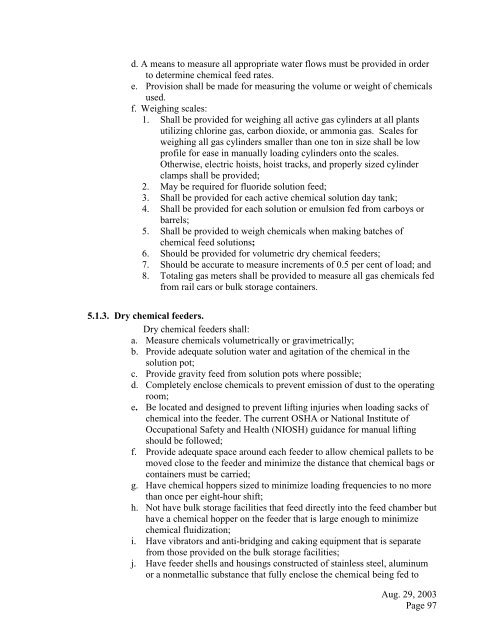Design Guide for Community Water Systems - The Water, Sanitation ...
Design Guide for Community Water Systems - The Water, Sanitation ...
Design Guide for Community Water Systems - The Water, Sanitation ...
You also want an ePaper? Increase the reach of your titles
YUMPU automatically turns print PDFs into web optimized ePapers that Google loves.
d. A means to measure all appropriate water flows must be provided in orderto determine chemical feed rates.e. Provision shall be made <strong>for</strong> measuring the volume or weight of chemicalsused.f. Weighing scales:1. Shall be provided <strong>for</strong> weighing all active gas cylinders at all plantsutilizing chlorine gas, carbon dioxide, or ammonia gas. Scales <strong>for</strong>weighing all gas cylinders smaller than one ton in size shall be lowprofile <strong>for</strong> ease in manually loading cylinders onto the scales.Otherwise, electric hoists, hoist tracks, and properly sized cylinderclamps shall be provided;2. May be required <strong>for</strong> fluoride solution feed;3. Shall be provided <strong>for</strong> each active chemical solution day tank;4. Shall be provided <strong>for</strong> each solution or emulsion fed from carboys orbarrels;5. Shall be provided to weigh chemicals when making batches ofchemical feed solutions;6. Should be provided <strong>for</strong> volumetric dry chemical feeders;7. Should be accurate to measure increments of 0.5 per cent of load; and8. Totaling gas meters shall be provided to measure all gas chemicals fedfrom rail cars or bulk storage containers.5.1.3. Dry chemical feeders.Dry chemical feeders shall:a. Measure chemicals volumetrically or gravimetrically;b. Provide adequate solution water and agitation of the chemical in thesolution pot;c. Provide gravity feed from solution pots where possible;d. Completely enclose chemicals to prevent emission of dust to the operatingroom;e. Be located and designed to prevent lifting injuries when loading sacks ofchemical into the feeder. <strong>The</strong> current OSHA or National Institute ofOccupational Safety and Health (NIOSH) guidance <strong>for</strong> manual liftingshould be followed;f. Provide adequate space around each feeder to allow chemical pallets to bemoved close to the feeder and minimize the distance that chemical bags orcontainers must be carried;g. Have chemical hoppers sized to minimize loading frequencies to no morethan once per eight-hour shift;h. Not have bulk storage facilities that feed directly into the feed chamber buthave a chemical hopper on the feeder that is large enough to minimizechemical fluidization;i. Have vibrators and anti-bridging and caking equipment that is separatefrom those provided on the bulk storage facilities;j. Have feeder shells and housings constructed of stainless steel, aluminumor a nonmetallic substance that fully enclose the chemical being fed toAug. 29, 2003Page 97
















